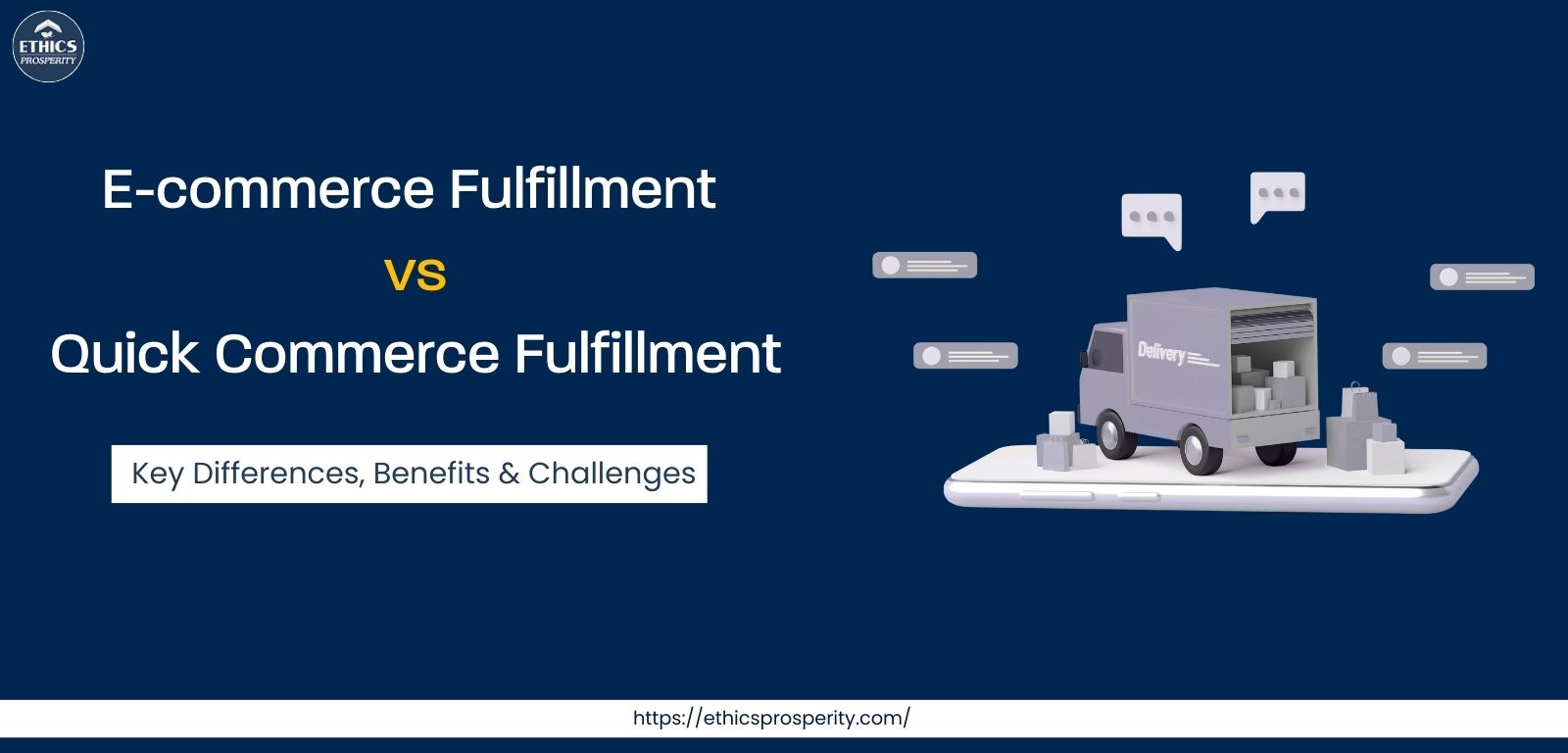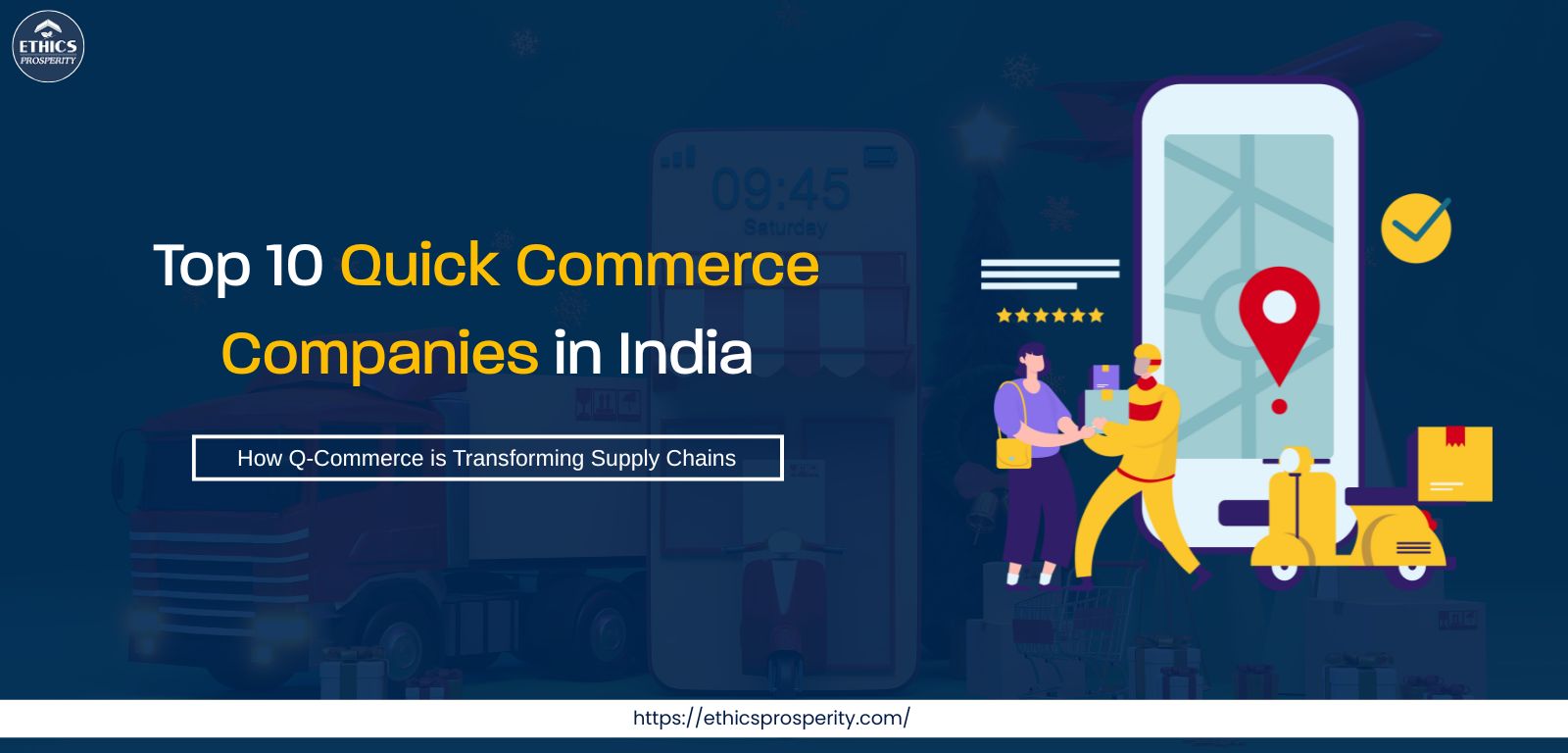The digital retail landscape has transformed rapidly over the last decade. E-commerce fulfillment revolutionized global retail, making online shopping accessible across geographies. Today, we’re witnessing the rise of quick commerce (Q-commerce), an ultra-fast model where deliveries happen in as little as 10–30 minutes.
For businesses, understanding the differences between e-commerce and quick commerce fulfillment is more than an operational decision—it’s a strategic choice that impacts customer loyalty, supply chain efficiency, and long-term profitability.
This blog explores the evolution, processes, benefits, and challenges of both models while providing insights into last-mile delivery, the Q-commerce supply chain, and future trends shaping global retail.
What is E-commerce Fulfillment?
E-commerce fulfillment is the end-to-end process of storing, processing, and delivering online orders to customers. It is a cornerstone of end-to-end supply chain management, enabling brands to meet growing consumer demand efficiently.
Types of E-commerce
B2C (Business-to-Consumer): Direct orders from businesses to individuals (Amazon, Flipkart).
B2B (Business-to-Business): Bulk order fulfillment between companies (industrial suppliers, wholesale).
- D2C (Direct-to-Consumer): Brands selling directly to customers via their own channels (Nike.com).
Key Components of E-commerce Fulfillment
Inventory Management & Storage – Centralized warehouses store a wide range of products.
Order Processing (Picking, Packing & Labeling) – Standardized processes for large-volume accuracy.
Shipping & Carrier Coordination – National and international carriers manage delivery networks.
Returns & Reverse Logistics – Strong systems for managing returns, exchanges, and recycling.
- Fulfillment Technology & Integration – ERP, WMS, and blockchain in supply chain solutions enhance visibility.
What is Quick Commerce (Q-commerce) Fulfillment?
Quick commerce fulfillment, or Q-commerce, is designed for speed—delivering products in under 30 minutes. It relies on hyperlocal delivery networks and micro-fulfillment centers near urban customers.
Core Features of Quick Commerce Fulfillment
Dark Stores & Micro-fulfillment Centers: Compact warehouses placed close to demand hubs.
Limited Inventory, High Turnover: Only fast-moving SKUs (groceries, medicines, FMCG) are stocked.
Real-time Order Picking & Dispatch: AI-driven picking ensures orders are packed within minutes.
Gig Workforce & Last-mile Delivery Agents: Reliance on local delivery fleets for ultra-fast service.
- Ultra-fast Customer Expectations: Meeting the promise of speed to gain brand loyalty.
E-commerce vs Quick Commerce Fulfillment: 7 Key Differences
 1. Delivery Speed
1. Delivery Speed
E-commerce Fulfillment: Typically ranges from 1 to 7 days, depending on whether the item ships from a local warehouse, a regional hub, or across borders. Speed is important, but not the primary promise.
Quick Commerce Fulfillment: Delivery happens in 10–30 minutes because products are stored in micro-fulfillment centers or dark stores located close to the customer. Here, speed is the main selling point.
2. Order Size & Frequency
E-commerce: Customers usually place larger baskets (multiple items) but order less frequently, e.g., monthly household shopping or bulk electronics orders.
Quick Commerce: Orders are smaller but more frequent—a couple of items like snacks, medicines, or daily essentials, often multiple times a week.
3. Inventory Strategy
E-commerce: Uses centralized warehouses or regional distribution centers holding thousands of SKUs. Products are shipped nationally or even internationally.
Quick Commerce: Relies on dark stores and hyperlocal hubs that stock only fast-moving SKUs (groceries, beverages, FMCG essentials).
4. Technology & Automation
E-commerce: Managed with ERP, Warehouse Management Systems (WMS), and sometimes blockchain in smart warehousing for better traceability and efficiency.
Quick Commerce: Driven by AI algorithms, predictive analytics, and IoT sensors to enable real-time picking, inventory updates, and optimized dispatch routes.
5. Last-mile Delivery Approach
E-commerce: Uses national and regional carriers like FedEx, Blue Dart, or Delhivery. Delivery is more structured, often routed through multiple hubs.
Quick Commerce: Depends heavily on the gig economy—local riders on bikes, scooters, or EVs. The last mile is hyperlocal, covering 2–3 km radiuses.
6. Customer Expectations
E-commerce: Customers expect variety, choice, and cost savings (discounts, bulk deals). Time sensitivity is secondary.
Quick Commerce: Customers demand speed and convenience. If an item takes longer than 30 minutes, the value proposition is lost.
7. Cost & Scalability
E-commerce: Benefits from economies of scale. Larger shipments reduce per-unit costs, making it highly scalable globally.
Benefits of E-commerce Fulfillment
Scalability: Handles large volumes, supporting global expansion.
Cost Optimization: Bulk shipping reduces per-unit costs.
Cross-Border Potential: Access to global markets.
- Reverse Supply Chain Management: Strong systems for returns and replacements.
Benefits of Quick Commerce Fulfillment
Ultra-Fast Customer Satisfaction: Meeting expectations within minutes.
Competitive Advantage: Captures urban, time-sensitive customers.
Repeat Orders: Encourages high-frequency purchases.
- Brand Loyalty: Builds trust through convenience.
Challenges of E-commerce Fulfillment
Seasonal demand spikes increase complexity.
Managing reverse supply chain at scale is costly.
Rising cross-border compliance regulations.
- Warehousing and carrier costs continue to grow.
Challenges of Quick Commerce Fulfillment
High Operational Costs: Maintaining dark stores and delivery agents.
Workforce Reliability: Dependence on gig workers.
Inventory Constraints: Limited product range.
- Profitability Pressure: High competition and low margins.
Choosing the Right Fulfillment Strategy for Your Business
Businesses must evaluate:
Product Type: Perishables vs non-perishables.
Geography: Urban vs rural markets.
Order Size: Large baskets vs micro-purchases.
- Customer Expectations: Speed vs cost.
Hybrid Fulfillment Models
Many supply chain companies in India are adopting hybrid strategies, blending scale of e-commerce with speed of quick commerce. Example: Large e-commerce warehouses supported by custom warehousing for Q-commerce in metro cities.
The Future of E-commerce and Quick Commerce
The future lies in digital integration and sustainability:
AI & Automation: Predict demand and optimize picking.
Blockchain in Supply Chain: Secure and transparent transactions across stakeholders.
Micro-fulfillment Expansion: Dark stores across urban areas.
Sustainable Last-Mile Delivery: Electric fleets and eco-friendly packaging.
Conclusion
Both e-commerce fulfillment and quick commerce fulfillment are vital to modern supply chains. While e-commerce provides scale and cost efficiency, Q-commerce delivers speed and convenience.
For businesses, the choice isn’t always “either-or.” The future will see blended strategies—where scale, speed, and last-mile delivery excellence converge to define global competitiveness.

